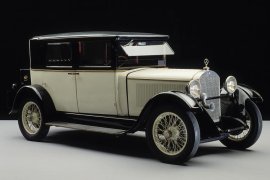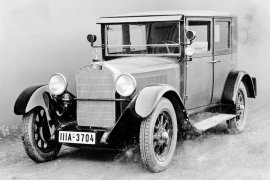MERCEDES BENZ Typ 8/38 Models/Series Timeline, Specifications & Photos
First production year: 1926
Engines: Gasoline
Two years after the introduction of the 8/38 model, the automaker decided to create a more luxurious version for it that was launched in 1928: the Stuttgart version.
Mercedes & Cie and Daimler-Motoren-Gesselschaft (DMG) joined forces in 1926, forming Mercedes-Benz, the Typ 200 was their first joint project. So they made an affordable yet high-quality vehicle. Sales went through the roof during those times, and that made the carmaker dare a little bit more. Thus, in 1928, it launched the Stuttgart version, which was based on a longer chassis and provided more comfort, and was more luxurious than its 1926 model-year sibling.
Sporting the same front fascia as its shorter sibling, the Stuttgart version was available with an option for wire wheels instead of steel-artillery ones as its predecessor. From its sides, the longer wheelbase and chassis were used to provide more legroom for the rear-seated passengers. Thus, those who paid for the vehicle were happier with the car.
With a vast rear compartment and expensive materials, the 8/38 Stuttgart conquered its customers. The center-mounted instrument panel on the wooden dashboard and the four-spoke steering wheel were carefully crafted. The fit and finish were above the market's standards.
Even though the vehicle increased in size and weight, the automaker decided to keep the same powerplant and drivetrain as in the 1926 model year. This way, it kept the development's cost low. Its inline-six powerplant developed 38 PS (37 hp) from the two-liter displacement that it sent to the rear wheels via a three-speed manual with a floor-mounted gearstick.
After the merger between Daimler-Motoren-Gesselschaft (DMG) and Benz & Cie., a new brand was formed by the name of Mercedes-Benz, and the first production model was the 1926 8/38.
These two companies struggled to decide whether to go for affordable or luxurious vehicles. Each of them had a point, but the market was the final decider. So, after a long gestation period, the carmaker introduced the 8/38 (W02) on the market in 1926. The prototype for this vehicle was the W01, but it never reached production. The nameplate suggested the engine had 38 PS (37.5 hp), while the 8 was for displacement-based fiscal power. In 1928, the car also got the Typ 200 nameplate added, where that number stood for the two-liter engine.
Mercedes-Benz produced this affordable vehicle in large numbers. Its bodywork was simple, with squared lines and flat panels. The design was similar to most other vehicles from that era. Moreover, its radiator was simple but with an arched line at the top. A feature that followed for decades after it was the horizontal bar that connected the arched wheel fenders where the automaker installed the headlights. From its profile, the car boasted a set of multi-spoke wooden wheels (artillery wheels), and the engine compartment's side lid sported louvers that helped to cool the engine. Thanks to the rear-hinged rear doors, access in the back was easy, while at the front were regular ones. Behind the vehicle, the automaker placed the spare wheel.
The cabin wasn't luxurious but well-built and had decent materials. Furthermore, its four-spoke steering wheel, wooden dashboard, and side windows were very appreciated at those times when many vehicles didn't even sport a roof.
DMG developed an inline-six powerplant for this vehicle, and while it wasn't a masterpiece, it was sturdy. In addition, it served as a base for future developments, with engine displacements of up to three liters.

